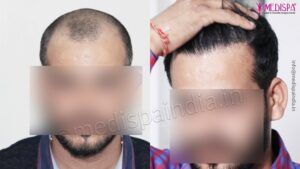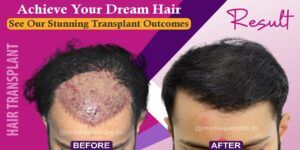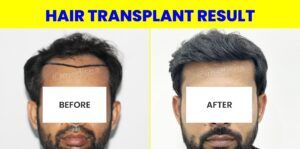
Being burnt is an extremely unpleasant experience, and having severe scars makes it much harder to go on. Although the burn’s degree might vary, everyone experiences pain that is hard to put into words.
Patients may be disturbed if they have permanent hair loss and severe scars. A hair transplant would be the best treatment for hair loss once the desired modifications have been made to the body. A series of plastic surgeries are planned to remove scars from burning cases.
Even if the suffering you endured would never truly go away, having better hair and appearance thanks to cosmetic operations would undoubtedly boost your confidence. You would have the finest potential hair growth and excellent hair restoration via a hair transplant.
Hair transplantation is a laborious and challenging technique that can be accomplished for burn sufferers. These instances require a skilled and experienced surgeon since if the treatment is not carried out precisely, it is likely to fail. It is preferable to be in safe hands because burn sufferers are already extremely sensitive and cannot handle any additional stress.
Burn alopecia
Burn alopecia, the term for hair loss brought on by burns, is linked to severe scarring. Burn alopecia frequently affects the face, eyebrows, eyelashes, and scalp—aesthetic regions that are visible and require medical attention. It is unsightly and considerably more obvious because of the scars. The scars might be covered up with hair to provide an aesthetically pleasing appearance.
Hair transplants in general
A hair transplant is a minimally invasive surgical treatment used to restore hair to the bald region or correct an unattractive hairline in order to address hair loss caused by any cause. Hair follicles from the donor area—selected for its capacity to withstand DHT—are transferred to the recipient bald area during the operation.
Methods to perform hair transplant
There are two hair transplant procedures available: FUE and FUT.
FUT hair transplantation is sometimes referred to as the “strip method” as a little strip from the donor region is removed during the process. The strip is cut into pieces and thoroughly magnified before each hair root is removed. The donor region is sutured back together after the hair roots are properly transplanted in the designated bald spot.
On the other hand, a punch-shaped piece of equipment is used during the FUE hair transplant operation to extract each individual hair root. After being inserted into the skin, the punch device is pulled along with the hair root. The extracted hair roots are then sown into the designated bald area.
Three thousand to three thousand and five hundred hair roots can be extracted throughout the FUT process. For severe baldness, this is often the suggested treatment. It is possible to remove 2000–2500 hair roots with a FUE hair transplant. For early baldness or facial hair transplants, this technique is usually advised.
Hair transplant in burn victims
Hair transplantation is a viable option for burn patients, but the surgeon must choose carefully who to transplant. To ascertain whether there are sufficient hair follicles to proceed with the therapy, the donor region is extensively checked. It is essential that the donor region have healthy hair follicles because of the burn and damage. In addition, the surgeon needs to choose DHT-resistant hair follicles and exercise caution when harvesting too much from the donor location.
It is extremely difficult to treat burn victims with hair transplants; depending on the amount of baldness and the density of available hair, numerous sessions may be needed. The follicular transplants that are taken from healthy scalps are not particularly dependable. In these situations, the graft survival percentage is extremely low, ranging from 0% to 90%. In the event that the burn sufferer has further head injuries, those should be addressed before considering a hair transplant.
Sadly, not every patient who has suffered from burns is a good candidate for a hair transplant. To be sure, the patient must be properly evaluated at the initial appointment. A variety of criteria are taken into consideration when confirming a candidate, including the degree of baldness, the quantity of follicular grafts needed, the location of scarring, the availability of hair density at the donor site, and any associated traumas.
For these individuals, a customized treatment plan needs to be created by the surgeon. A thorough treatment plan, professional persistence, and the appropriate method are essential for the hair transplant to be effective. You need to carefully choose the most capable group of people in order to complete the work effectively.
Due to his worldwide reputation for managing complex and severe cases of hair loss, Dr. Suneet Soni is the greatest option if you’re searching for a reliable doctor to do the best hair transplant. His vast experience, impressive credentials, and proficiency all contribute to his improved trustworthiness. He is well known for both his exceptional creative talent and medical competence worldwide. It’s probable that the hair roots of these folks are quite fragile. Handling hair roots gently is essential to preserve the precious hair root.
India is a highly popular travel destination for people seeking hair transplants, bringing visitors from all over the world. There are very few Indian doctors who are well known for their proficiency in this field. Dr. Suneet Soni is regarded as one of the top surgeons for hair transplant in India and is very skilled. Due to India’s excellent standards of care and affordable hair transplant cost in India, patients come from all over the world for these procedures.
In addition to offering the best hair loss treatment choices, our skilled staff assures that you will receive the most pleasant care possible. We are aware of your difficulties. Our best hair transplant treatment together with our compassion will restore your physical and mental well-being.







